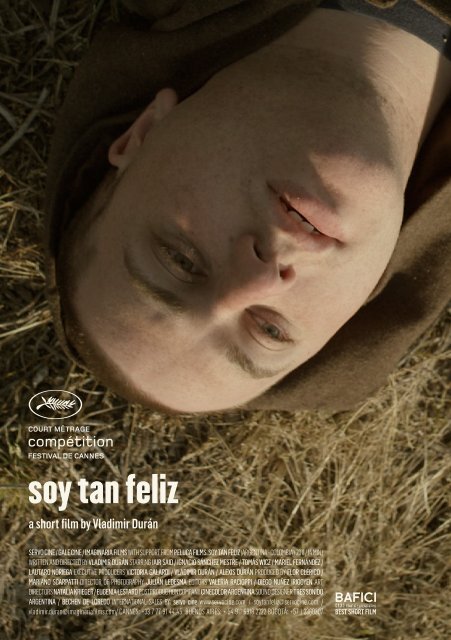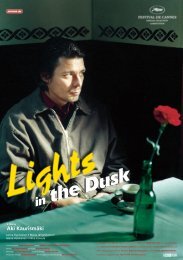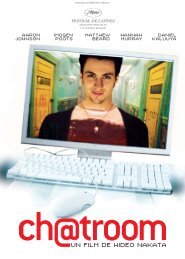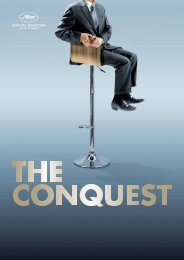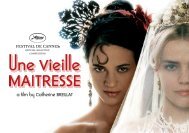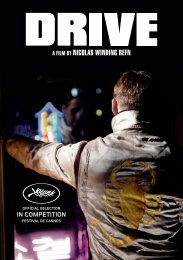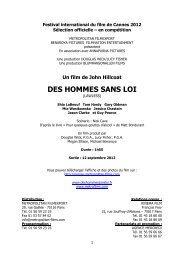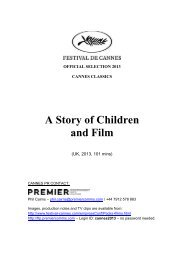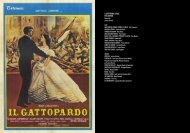soy tan feliz - Festival de Cannes
soy tan feliz - Festival de Cannes
soy tan feliz - Festival de Cannes
Create successful ePaper yourself
Turn your PDF publications into a flip-book with our unique Google optimized e-Paper software.
<strong>soy</strong> <strong>tan</strong> <strong>feliz</strong><br />
BEST SHORT FILM
2 3<br />
synopsis.<br />
Fragments of a Saturday winter day. The Vittenzein brothers are<br />
alone at their family house. Mateo stops by to pick up Bruno and<br />
Camilo and drive them to the country house where their mother<br />
awaits. A sud<strong>de</strong>n break slam brings them into the intimacy of a<br />
waste land.<br />
Bribes d’un samedi d’hiver. Les frères Vittenzein se retrouvent<br />
seuls dans la maison familiale. Mateo passe chercher Bruno et<br />
Camilo pour les emmener à la maison <strong>de</strong> campagne où les attend<br />
leur mère. Un arrêt imprévu les rapproche dans l’intimité d’un<br />
terrain vague.<br />
the director’s view.<br />
le regard du réalisateur.<br />
Soy <strong>tan</strong> <strong>feliz</strong><br />
An erratic pain is a chronic pain, which goes from one place to<br />
another having no fixed ground, and can be felt randomly yet on<br />
one part, yet on another part of the body.<br />
I like to think that the few minutes that make up “Soy <strong>tan</strong><br />
Feliz” are composed by erratic fragments of a winter Saturday spent<br />
together by a group of teenagers. Pieces of time, which feel as if<br />
disposed by mere chance, which do not compose a structured narrative,<br />
but reveal moments of introspection, emotional states in tiny<br />
<strong>de</strong>tails, bonds, <strong>de</strong>sires and of course, <strong>de</strong>ep pains.<br />
I aim for the lights to turn on and off cons<strong>tan</strong>tly. May<br />
what we are able to see be just portions of something much more<br />
broad. Something that can only be sensed, assuming the risks of an<br />
unpredictable narration that for moments may seem to drift, from<br />
a zigzagging and yes, erratic, process, in which prevails an intimate<br />
conflict which connects to the root of my own conflicts. Without<br />
any closure or conclusive turnabout. Just fragments.<br />
Une douleur erratique est une douleur chronique qui passe d’une<br />
zone à l’autre sans avoir <strong>de</strong> foyer fixe et qui se manifeste <strong>de</strong> manière<br />
aléatoire.<br />
J’aime penser que les quelques minutes <strong>de</strong> ‘Soy <strong>tan</strong> <strong>feliz</strong>’<br />
sont composées <strong>de</strong> fragments erratiques d’un samedi d’hiver entre<br />
adolescents. Morceaux <strong>de</strong> temps, choisis au hasard qui ne composent<br />
pas une ligne narrative structurée mais qui révèlent <strong>de</strong>s moments<br />
d’introspection, états émotionnels, liens, désir et aussi <strong>de</strong> profon<strong>de</strong>s<br />
douleurs.<br />
Je cherche à ce que la lumière s’allume et s’éteigne sans<br />
arrêt. Que ce qu’on voie soit seulement <strong>de</strong>s portions <strong>de</strong> quelque<br />
chose <strong>de</strong> beaucoup plus ample. Une chose qui puisse seulement être<br />
pressentie, en assumant le risque d’une narration imprédictible qui par<br />
moment puisse se sentir comme à la dérive, un <strong>de</strong>venir zigzaguant<br />
et en effet, erratique où la seule chose qui prédomine est un conflit<br />
intime connecté avec les racines <strong>de</strong> mes propres conflits. Sans conclusion,<br />
ni épilogue. Des fragments.
4 5<br />
a view from<br />
outsi<strong>de</strong>.<br />
Review<br />
“Soy Tan Feliz”:<br />
Haircuts and the<br />
Cut of Love.<br />
le regard du<br />
<strong>de</strong>hors.<br />
Article by<br />
David Ranghelli<br />
Associate Professor at New York University’s Tisch School of the Arts.<br />
Soy <strong>tan</strong> <strong>feliz</strong><br />
The film Soy Tan Feliz by Vladimir Duran is a beautiful, visually<br />
compelling film which presents the spectator with a simple<br />
narrative carefully embed<strong>de</strong>d in a richly layered composition<br />
of images which are suggestive of more complex content than<br />
the main storyline presents. This economy of images is the real<br />
pleasure that the short film can offer: each image must signify,<br />
however simply.<br />
The film’s opening sequence clearly imparts to the spectator the<br />
main subject of the film- the unvoiced <strong>de</strong>sire of one male teenager<br />
for another. But the story is told in a manner that gives us the<br />
feeling of pure cinema. The distinctive use of images is what<br />
draws us into the film, and into a story whose scope expands<br />
surprisingly as we watch it.<br />
The literal narrative is minimal; the full story, one of<br />
<strong>de</strong>ep human emotion, is told through Duran’s system of images.<br />
The carefully orchestrated use of mirrors and windows, the extreme<br />
juxtapostion of frame sizes, the reversing of negative and<br />
positive screen space from one si<strong>de</strong> of the frame to the other<br />
in scene sequences, and the portrayal of apparently mundane<br />
activities among the film’s five ambiguously related characters.<br />
These activities can finally be recognized as activities which<br />
echo the main action of the film (which will be discussed below).<br />
The motif of liquid is present in each section, and is used to chart<br />
the arc of events. Lastly, what is secretly compelling is Duran’s<br />
<strong>de</strong>velopment of the dynamics of <strong>de</strong>sire through a system of characters<br />
observing each other, a system of looks and observation.<br />
The main story concerns the <strong>de</strong>sire that one young man<br />
(Bruno) has towards another young man who he knows (Mateo).
6 7<br />
There are three main sections in the film. The first occurs in a<br />
hair salon (a “unisex” place; a mixed gen<strong>de</strong>r space), the second at<br />
Bruno’s home (a place of ambiguity in the relationships and activities<br />
of the characters), and the third in a roadsi<strong>de</strong> field (a wi<strong>de</strong><br />
open space of “play”, confusion, and (mis)interpretation).<br />
In the beginning Bruno watches Mateo get a haircut at<br />
the salon; a military style “buzzcut”. The film opens with several<br />
shots of Bruno. He is first shown through an opaque haze of light,<br />
then in a series of sharper short shots with a documentary feel.<br />
In these shots our first liquid motif appears; a <strong>de</strong>liberate over<br />
discussion of hair gel. Bruno’s admiration is initially unclarified<br />
and ambiguous as we see the haircut, because Bruno is timid. But<br />
the story here is told visually, using a system of mirrors and windows.<br />
The two males are framed mostly apart, and when they are<br />
framed together it is their reflections we see, but reflected in separate<br />
mirrors: together yet apart. This is one of two haircut scenes<br />
which is central to the mediation of <strong>de</strong>sire presented to us. Bruno<br />
is ejected from the salon by the narcissistic Mateo when Bruno<br />
lights a cigarette. He continues to watch from outsi<strong>de</strong> through a<br />
window pane, a glass barrier between the two, featuring photos of<br />
<strong>de</strong>sireable hairstyles that we suppose clients want to “look like”;<br />
the salon is a site of the universal <strong>de</strong>sire- the <strong>de</strong>sire to be wanted-<br />
and the method, by imitating the s<strong>tan</strong>dard styles in the photos.<br />
Bruno’s look says everything about his state of mind: his stare<br />
says he wants, but a certain timid blankness reflects his inertia, like<br />
the hazy light which enshrouds him in the film’s beginning.<br />
When we get to Bruno’s house a surprise third participant<br />
enters this chain of <strong>de</strong>sire. The scene opens with Camilo,<br />
a blon<strong>de</strong> boy (about 10 yeas old), who is watching TV. He has a<br />
serious, perplexed look which he wears through most of the film.<br />
In a wi<strong>de</strong>r shot we see he and Bruno are in a house together. He<br />
turns and gives Bruno, in the foreground, a long, serious look.<br />
Then he continues watching TV. Bruno is at the computer. He<br />
finishes (loses?) his game, and inci<strong>de</strong>ntally it is only now the title<br />
Soy <strong>tan</strong> <strong>feliz</strong><br />
appears, roughly 3:30 into the film: Soy Tan Feliz. Camilo’s look<br />
at his brother <strong>de</strong>fines an interplay in the second section, which<br />
manifests itself in the third section at the field where the only<br />
characters are Bruno, Mateo and the observing Camilo.<br />
The second section at Bruno’s house is quite won<strong>de</strong>rful,<br />
giving us both a clear course of action by Bruno and scenes<br />
which playfully echo his action, while building up a certain tension<br />
through their randomness and variations in frame size and<br />
focal length. After being shown Eduardo’s tattoo (like a “prisoner”)<br />
by Andrea, Bruno goes up to the bathroom. Mateo arrives at<br />
the pool. Bruno sees everyone at poolsi<strong>de</strong> through another closed<br />
window, where both he and the audience have a clear view. They<br />
are still separated by a class barrier. The water motif reappears<br />
throughout this scene. Bruno washing at the sink. The others at<br />
the poolsi<strong>de</strong>, playing. In opposition to the gel, which “fixes” thing<br />
(hair) in place, the water in this section seems to suggest fluidity<br />
and playfulness. The others dunk their hair in the pool, Bruno<br />
showers, as a prelu<strong>de</strong> to his transformative, <strong>de</strong>cisive act: he cuts<br />
his own hair, by himself, all alone. This is intercut with short moments<br />
of the games and hanging around of the other four characters.<br />
Camilo is framed with Mateo in most of these scenes, often<br />
happily, including the last shot of the section where they are lying<br />
down together.<br />
These images give us a “home movie”- slice of life feeling.<br />
The shots and scenes are not causally connected, but rather float<br />
in quiet juxtaposition against each other. The presence of water<br />
un<strong>de</strong>rscores this. We are subtly presented with a scheme of parallel<br />
action, Andrea painting her toenails, people making funny faces<br />
or gestures, the young boys doing a tap dance together, intercut<br />
with the lackadaisical Bruno pon<strong>de</strong>rously giving himself a sloppy<br />
buzzcut, which further <strong>de</strong>monstrates both his admiration of and<br />
<strong>de</strong>sire for Mateo. But it is a lonely haircut.<br />
If we consi<strong>de</strong>r the haircuts as efforts to adorn the self, or<br />
to mark the self, all the other characters follow this course of ac-
8 9<br />
tion, echoing Bruno’s haircut, except one: Bruno’s brother Camilo<br />
(about 10). The girl (his sister Andrea) painted her toenails, and<br />
another young boy (Eduardo, also about 10) is tattooed, like in<br />
jail. Camilo is playful, but still observant.<br />
The next and climactic scene in the film returns us to the<br />
motif of glass, mirrors and windows as an impor<strong>tan</strong>t motif. When<br />
the two boys and Camilo are in the car we see them from the position<br />
of the windshield, through the windshield. The three males<br />
are united in this space.<br />
Water is again introduced, but its valence has changed. Camilo<br />
gives Bruno an open bottle of water which spills on Bruno. Mateo<br />
knocks even more water on him. Bruno punches Mateo.<br />
Sud<strong>de</strong>nly Mateo stops the car and he and Bruno run out, with an<br />
air of urgency disconcerting to Camilo. They wrestle in a roadsi<strong>de</strong><br />
field. They leave Camilo alone and confused. In fact the scenes<br />
of Camilo walking along the highway are alarming, and create<br />
an alternate tension to what is happening on the grass, where<br />
Bruno and Mateo are now together; no mirrors, no glass barriers.<br />
Bruno and Mateo enter into a confused mixture of roughhousing<br />
and foreplay, and Bruno is now quite aggressive; Mateo resis<strong>tan</strong>t.<br />
Without his hair Bruno too becomes brusque.<br />
Meanwhile Camilo studies a roadsi<strong>de</strong> altar with a statue<br />
of the virgin protected by glass when we hear the sound of a<br />
cellphone ringing. In the car answers it. We learn his mother is<br />
calling. Why is she calling now? This is a point of great interest<br />
as it brings on the ending of the film. Camilo calls Bruno to come.<br />
Bruno has been trying to become intimate with Mateo, but Mateo<br />
stops their encounter and leaves Bruno lying on the grass, and<br />
the story ends. After Camilo answered the phone, no one attends<br />
the phonecall.<br />
Why a call from mother? Adults have been absent from the<br />
film so far. Mother as absence? What functions does the call serve?<br />
Perhaps it is part of a humorous juxtaposition of the Virgin with the<br />
Soy <strong>tan</strong> <strong>feliz</strong><br />
homoerotic tussle playing out in the field, interrupted by a mother’s<br />
intervention? Mother as authority figure: “playtime” is over for the<br />
boys? Mother in response to taboo; to some kind of incestuousness?<br />
Mother as omniscience? Mother as a source of comfort for<br />
Camilo as she ends the confused behavior he observes, or perhaps<br />
that he feels, but cannot process? If we have tuned into Camilo’s<br />
presence throughout the film, to his appearance and his reactions,<br />
we may ask ourselves to what extent he is placed alongsi<strong>de</strong> Bruno<br />
at the center of the film’s portrayal of <strong>de</strong>siring.<br />
The opening shots of the film’s first two sections clue<br />
us about isolation, confusion and <strong>de</strong>sire as related to both Bruno<br />
and Camilo. The flow of images and the act of spectatorship (the<br />
watching by characters of others within the film) suggests a<br />
triangle of mediated <strong>de</strong>sires. Bruno watches Mateo. Bruno copies<br />
Mateo, perhaps hoping to signify that they are alike; that they are<br />
or should be one. Mateo, when watching at all, stares at himself<br />
narcissistically in the salon mirror (or wants Bruno to get his permission<br />
for haircuts). Camilo watches them both. If we dignify all<br />
of Duran’s images, the rest is a poetry of ambiguity. We are left<br />
without the closure the traditional narrative film dictates to us. In<br />
this way the beauty of the film masks the uncertainty of events,<br />
of the state of the relationships between the main characters,<br />
and of what resonances the interactions between Bruno and<br />
Mateo have for Camilo. In a way the film seems to be as much<br />
about Camilo’s spectatorship and his perplexed responses, as it<br />
is about the two ol<strong>de</strong>r boys.<br />
For this viewer the film offers a nexus of moments<br />
and emotions are ambiguously rich. Something in the film may<br />
touch the spectator; who may not be sure what exactly it is.<br />
That is the beauty of the storytelling aesthetics Vladimir Duran<br />
uses in Soy Tan Feliz. The images signify poetically, through<br />
their beauty, their structure, the openness of their signification,<br />
and their discreetness.
10 11<br />
director<br />
Soy <strong>tan</strong> <strong>feliz</strong><br />
Vladimir Durán was born in Bogotá, Colombia. He studied<br />
Anthropology at Université <strong>de</strong> Montréal, and Film Directing at<br />
Universidad <strong>de</strong>l Cine <strong>de</strong> Buenos Aires. He also studied acting<br />
and directing actors with Marketa Kimbrell, Nora Moseinco and<br />
Claudio Tolcachir. He works as a commercial director in Latin<br />
America and Europe, where he has won several awards in the<br />
most impor<strong>tan</strong>t advertising festivals.<br />
His short film “Soy <strong>tan</strong> <strong>feliz</strong>” was selected as part ot the Official<br />
Competiion at 2011 <strong>Cannes</strong> Film <strong>Festival</strong> and won Best Short Film<br />
Award at the 13th Buenos Aires International In<strong>de</strong>pen<strong>de</strong>nt Film<br />
<strong>Festival</strong>/ BAFICI 2011.<br />
Vladimir Durán est né à Bogota en Colombie. Il a étudié<br />
l’Anthropologie à l’Université <strong>de</strong> Montréal, Réalisation à La<br />
Universidad <strong>de</strong>l Cine à Buenos Aires ainsi qu’Art Dramatique<br />
et Direction d’acteur avec Marketa Kimbrell, Nora Moseinco et<br />
Claudio Tolcachir. En parallèle il travaille comme réalisateur <strong>de</strong><br />
films publicitaires dans plusieurs pays d’Amérique et d’Europe et<br />
a obtenu <strong>de</strong> nombreux prix dans les festivals les plus impor<strong>tan</strong>ts<br />
<strong>de</strong> publicité.<br />
Son court métrage ‘Soy <strong>tan</strong> Feliz’ a été sélectionné en compétition<br />
officielle au <strong>Festival</strong> <strong>de</strong> <strong>Cannes</strong> 2011 et a été primé ‘Meilleur Court<br />
Métrage’ à la 13ème édition du <strong>Festival</strong> Internacional <strong>de</strong> Cinéma<br />
Indépendant <strong>de</strong> Buenos Aires/ BAFICI 2011.
12 13<br />
cast<br />
/ crew<br />
Bruno<br />
Iair Said<br />
Mateo<br />
Ignacio Sánchez Mestre<br />
Camilo<br />
Tomás Wicz<br />
Andrea<br />
Mariel Fernán<strong>de</strong>z<br />
Eduardo<br />
Lautaro Noriega<br />
Soy <strong>tan</strong> <strong>feliz</strong><br />
Written and Directed by<br />
Vladimir Durán<br />
Executive Producers<br />
Victoria Galardi<br />
Vladimir Durán<br />
Alexis Durán<br />
Director of Photography<br />
Julián Le<strong>de</strong>sma<br />
Art Directors<br />
Natalia Krieger<br />
Eugenia Lestard<br />
Line Producers<br />
Flor Clérico<br />
Mariano Scarpatti<br />
Mara Paulon<br />
Marcelo Acosta<br />
With support from<br />
Peluca Films<br />
Fabio Cimmarusti<br />
Alejandro Di Michele.<br />
Editors<br />
Valeria Racioppi<br />
Alejandro Bro<strong>de</strong>rson<br />
Diego Nuñez Irigoyen<br />
Vladimir Durán<br />
Assis<strong>tan</strong>t Directors<br />
Flor Clérico<br />
Lucho Zazzarino<br />
Nacho Gaggero<br />
Postproduction Company<br />
Cinecolor Argentina.<br />
Sound Designer<br />
Tres Sonido (Argentina)<br />
Bechen <strong>de</strong> Loredo
14 15<br />
Soy <strong>tan</strong> <strong>feliz</strong><br />
2011 Argentina / Colombia COLOR 14 MIN Captured in RED CAM 2.35: 1. DCP Finished.
sales by<br />
servo cine.<br />
Amenabar 39.<br />
1426. Ciudad Autonoma <strong>de</strong> Buenos Aires.<br />
Republica Argentina.<br />
www.servocine.com<br />
E-mails: <strong>soy</strong><strong>tan</strong><strong>feliz</strong>@servocine.com<br />
vladimir.duran@imaginariafilms.com<br />
+ 54 911 6918 2222.<br />
contact <strong>Cannes</strong><br />
Vladimir Duran.<br />
+33 7 77 91 44 45.<br />
vladimir.duran@imaginariafilms.com<br />
Alexis Duran.<br />
Imaginaria Films Colombia.<br />
alexis.duran@imaginariafilms.com<br />
Raphaële Monnoyer.<br />
Gale Cine Argentina.<br />
raphaele@galecine.com.ar<br />
<strong>soy</strong> <strong>tan</strong> <strong>feliz</strong>.


